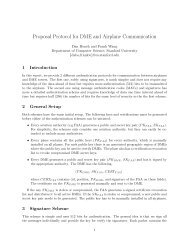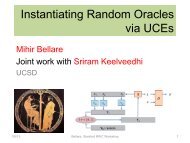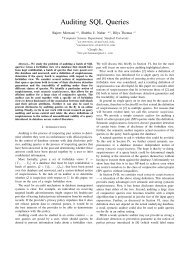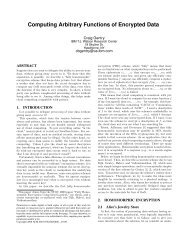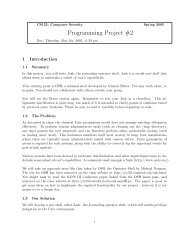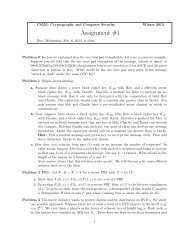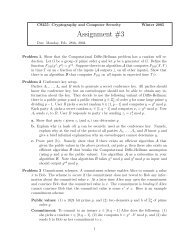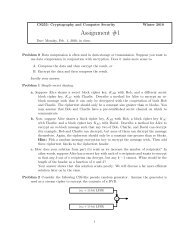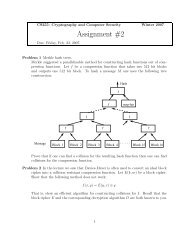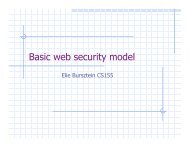Assignment #1: Solutions - Stanford Crypto Group
Assignment #1: Solutions - Stanford Crypto Group
Assignment #1: Solutions - Stanford Crypto Group
You also want an ePaper? Increase the reach of your titles
YUMPU automatically turns print PDFs into web optimized ePapers that Google loves.
Answer 4. (a) For every i ∈ {1,...,32}, a particular player ℓ has either key ki,0 or key ki,1, depending<br />
on bi—the i-th bit in the binary representation of ℓ. Given a ciphertext (i,c0,c1), player ℓ can obtain the<br />
message m by decrypting cbi .<br />
(b) Assume that the pirate decoder has the key Kj embedded. Suppose we feed the ciphertext Ci =<br />
( i, E(ki,0,m0), E(ki,1,m1) ) into the player, with m0 and m1 corresponding to observably different content.<br />
If the player plays content m0 (resp. m1) then it must possess the key ki,0 (resp. ki,1). Hence, by observing<br />
the result, we learn the i-th bit of index j. By feeding n different ciphertexts, we can retrieve the complete<br />
index j bit by bit.<br />
(c) Let in−1in−2 ...i0 and jn−1 jn−2 ... j0 be the binary representations of i and j respectively. Let a be an<br />
index where the two binary representation differ—i.e. a ∈ {0,1,...,n − 1} such that ia = ja. We build the<br />
pirate player P by replacing the a-th key in player i with the a-th key from player j. In other words, player<br />
P has the following key embedded:<br />
KP = k0,i0 ,k1,i1 ,...,k (a−1),ia−1 ,ka, ja ,k (a+1),ia+1 ,...,k <br />
(n−1),in−1<br />
Tracing algorithm from part (b) produces the index ℓ = in−1 ...ia+1 jaia−1 ...i0. Since ia = ja index ℓ is<br />
obviously different from i; since i ⊕ j is not a power of 2, index ℓ has to be different from j as well.<br />
Answer 5. (a) A simple way to construct an efficient adversary is as follows: Send the packet containing<br />
all 0s to the server to be encrypted. Since we are playing the CPA security game, the server will then send<br />
us the encryption of this packet, which we call c0. This packet will contain exactly the encryption of 0 ⊕ IV,<br />
where IV is the initialization vector chosen by the encryption system. Next, suppose we take the last block<br />
of c0 and XOR it with the all zeroes block to get p1. Sending across p1 to the server to be encrypted results<br />
in the following: E(p1) = E(c ′ 0 ⊕ c′ 0 ⊕ 0) = E(0), where c′ 0 refers to the last block of c0. This means our<br />
output is just the encryption of 0 and therefore, our next IV is 0.<br />
In the next phase of the game, we use two challenge plaintexts: the all zeroes plaintext referred to as m0<br />
and a randomly chosen string m1 = m0. Note that the encryption of m0 is E(0), which is already known. The<br />
encryption of m1 will be, with sufficiently high probability, something else. If the challenge string returned<br />
is equal to E(0), then we output the bit 0, i.e., guess that the original plaintext was m0. Otherwise, we guess<br />
1. We win the CPA game with probability very close to 1. This attack works with any fixed input that will<br />
constitute m0. We do not necessarily require the all zeroes string.<br />
(b) Re-encrypt the last block of the packet (with a new key derived from the original key in a secure<br />
manner) before using it as the IV. In order to predict the IV, the adversary would have to be able to guess the<br />
encryption of the ciphertext (which is distributed approximately uniformly at random) under some unknown<br />
key with a non-trivial success probability. An adversary that could do this would break the semantic security<br />
of AES, so we assume the method works.<br />
(c) Our CPA adversary A interacts with the challenger as follows. Send the query q ∗ = 0 n , the all-zeroes<br />
string. A receives C ∗ = ECBC(k,0 n ) that includes the IV chosen (let’s call it IV ∗ ) and the encrypted message<br />
block. For the semantic security challenge, A chooses M0 = 0 n and M1 = 1 n (or equivalently any other<br />
message). It receives Cb and must guess b. If Cb = C ∗ , output 0, else output 1.<br />
3



